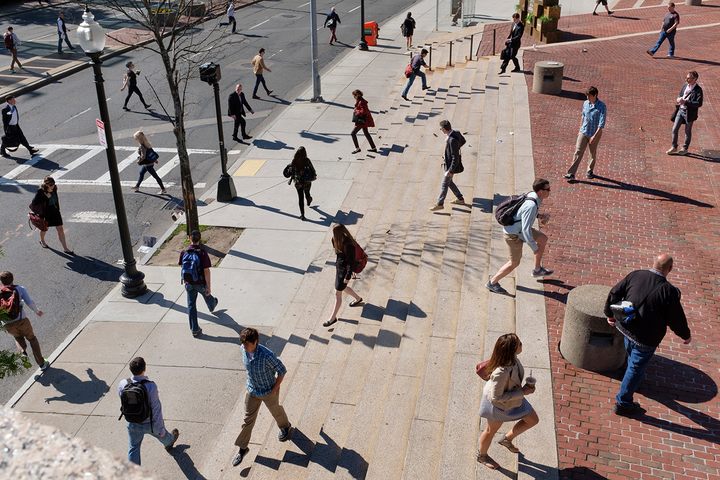
What a Socially Distant World Would Really Look Like
Photographer Pelle Cass creates six feet of separation everywhere he goes.
Pelle Cass is a street photographer—sort of. Since 2008, he’s been taking his camera and tripod to public plazas and tourist hubs in Boston, New York, and other major cities, where, over the course of an hour or more, he takes several hundred photos of a fixed point. Back in the editing room, he spends anywhere from 20 to 80 hours Photoshopping a single image, finding, masking, and layering the people that make it into the final frame—a “still time-lapse” of an urban afternoon.
In the series “Selected People,” no one is repositioned or altered; they’re selected or omitted. Here Cass creates worlds populated exclusively by one type of person—male professionals in blue button-ups, for instance, or couples, or people wearing red. In his popular sports series, “Crowded Fields,” the action of an early-season swim meet or a women’s intramural field hockey game (he prefers to shoot events the press rarely covers) is compressed, so that many moments appear at once.
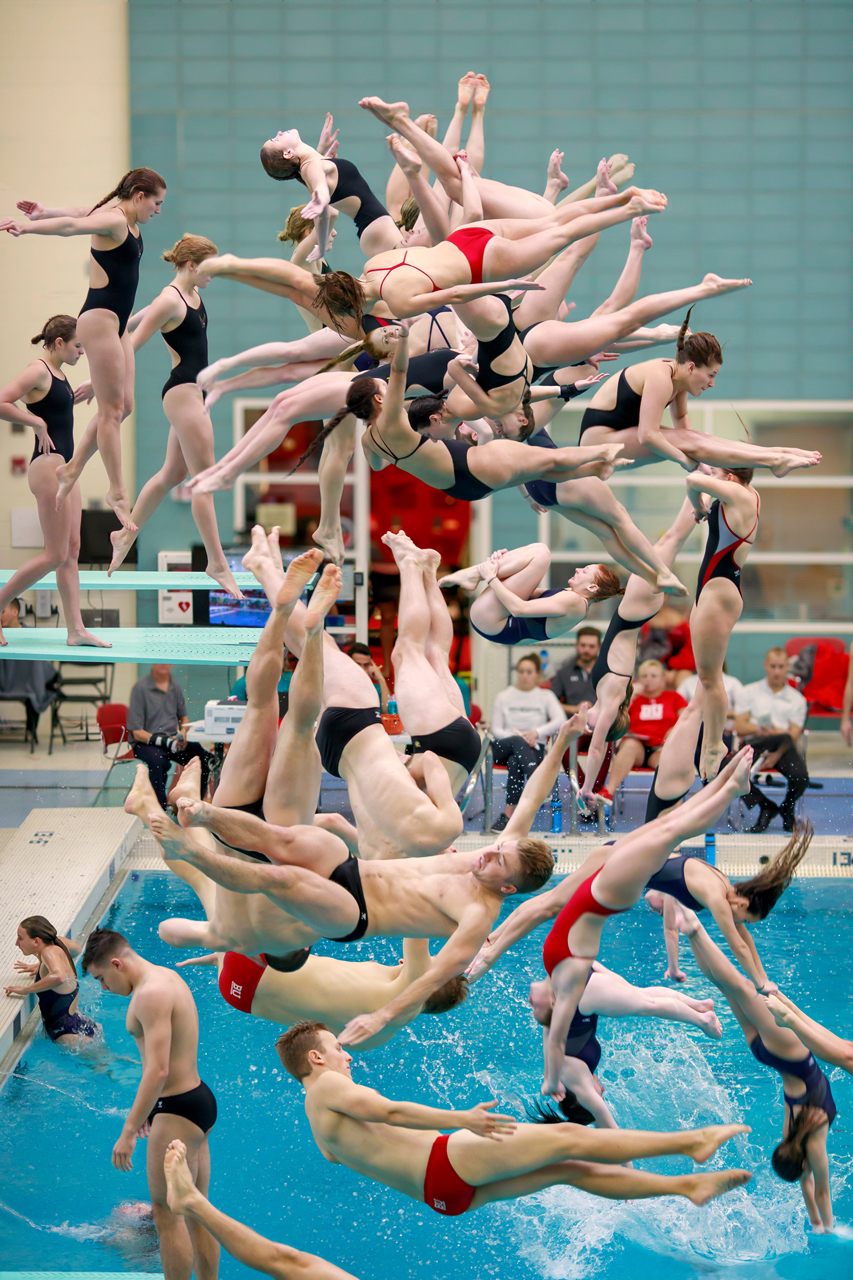
But claustrophobic images of overlapping bodies feel perverse during a global pandemic that spreads via person-to-person contact. Quarantined in his Brookline, Massachusetts, home since mid-March, Cass returned to his street scenes and sports pictures (and the thousands of individual photo files that comprise them). Then he reconstructed those images for the moment—replacing and removing some of the figures, so that every jogger and baby stroller crossing Harvard Bridge is now a perfect, socially distant six feet apart, and the balls on the tennis court hover freely and eerily, without players.
Cass rolls out the new edits on Instagram, where users express gratitude for his visualizations of a “new normal”—a new way of existing in a metropolis.
Atlas Obscura recently spoke with Cass about his series, and what it takes to bring to life a strange, spatially distant new world that, until recently, no one could have imagined.
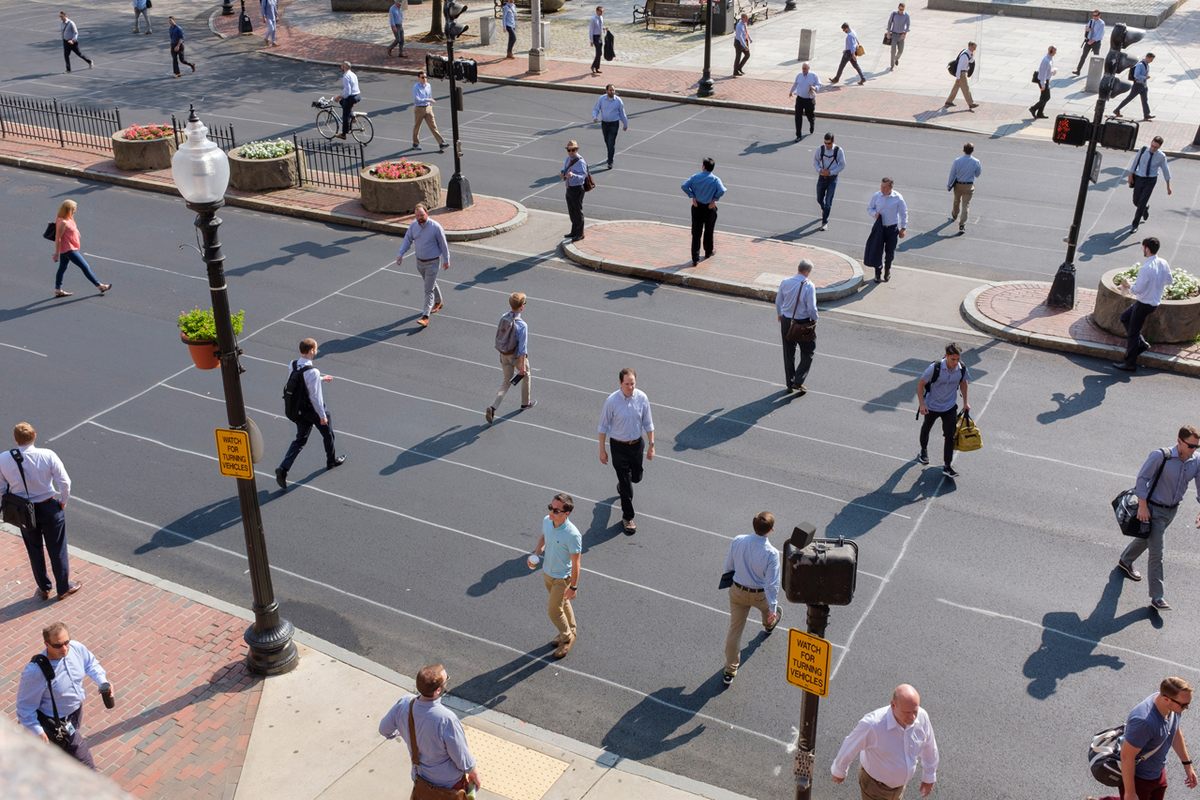
What prompted you to rework images from “Selected People” during quarantine?
I used to [say that] I would never rework these pictures, but I do sometimes come back to them when I have time off. This is the first time I’ve done it in a concentrated way. I was stuck at home, of course, and suddenly my pictures looked wrong to me. I don’t think my work is always joyful or happy, but people take them that way. I thought that if I’m going to do something new, the focus shouldn’t be on energy but rather deflation—how somber and thin life was starting to look.
What is the process of making images “for the current mood”?
Usually I’ll take, say, 2,000 pictures, then go through all of them and find the most interesting or exciting figures, gestures, and expressions. Now I find myself looking for stillness. I’ll go out for exercise at a time when people should be anxiously rushing to work, and it looks like a Sunday morning at 7 a.m. Then Sunday morning at 7 a.m. comes, and it looks the same.
I like that things were normal when I took the pictures. The past contained the future. It was there; I just had to separate it out. These reworked pictures present a fantasy of what things actually look like now, of people spaced evenly apart. In the future, cities will resemble the scenes that I’ve created from memory and out of the past.
I think of my street pictures as a representation of subjectivity: A human being will always focus their attention on some things over others. You can’t see everyone in the crowd; you can’t see everything that happens in an hour.
And that’s one reason I don’t get bored doing these pictures: The crisis has completely changed my subjectivity, so suddenly people look interesting when they’re isolated. Before they looked interesting smashed together. Both were equally true in the real world, as people overlapped in time and were isolated by time.

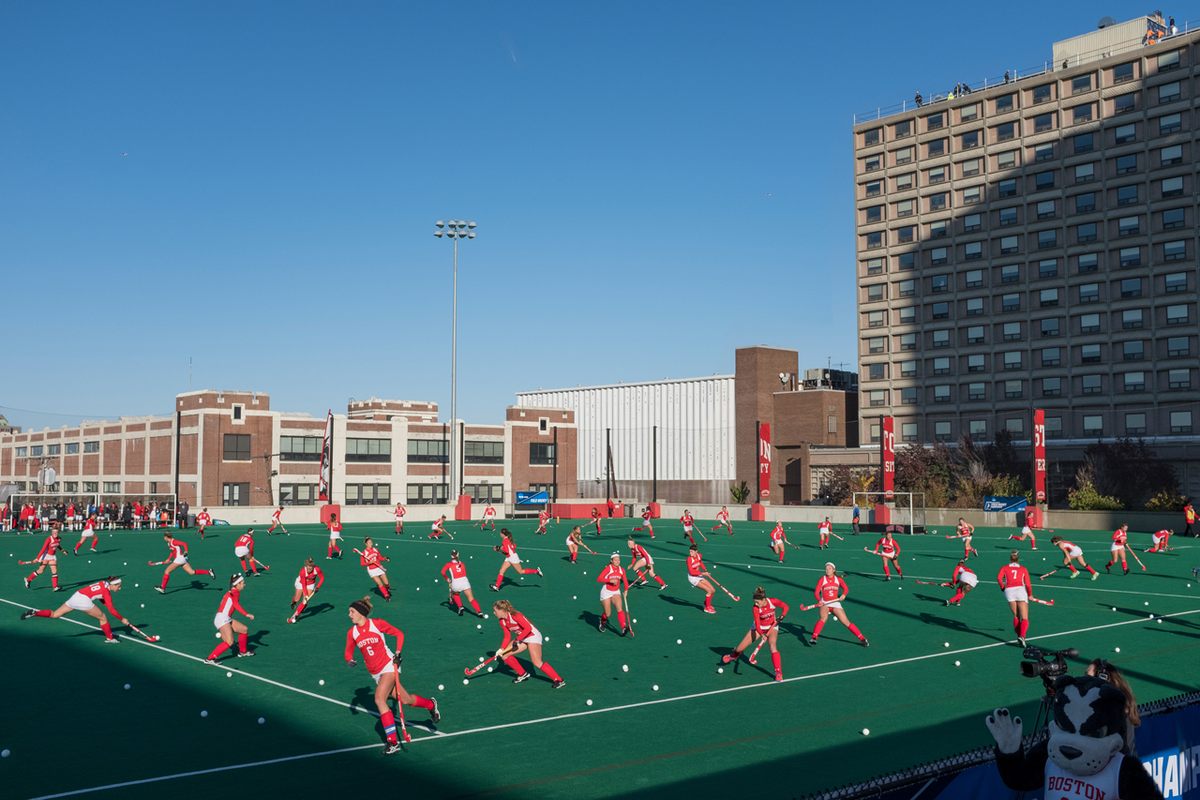
How do you think street photography will change with mandatory social distancing, anxiety about physical contact, and a shift to work-from-home culture?
There are a lot of visual clichés that rely on crowds. The new clichés of “photography in the time of coronavirus” happen instantly, like the portraits of people at windows with their hand on the glass. They’re nice, and they’re moving, but they become obvious.
Out in the city, people will look fundamentally different because they’ll [be wearing masks]. I’ll go photograph downtown, and I may find 30 people with masks and eight people without. And that will be interesting when you look at the picture, because it’s almost political—who is doing it and who is not?
I sort of like the masks, because I’m introverted. You really can avoid people. I like individuals, but I don’t like strangers or meeting people for the first time on the street. I don’t usually photograph something like a protest, because it’s too crowded, and I can’t find single figures that I find interesting.
I recently saw a picture in the paper of people protesting in a city where they had put dots across the plaza, perfectly ordered. And it was exactly like what I was currently working on: a sports picture where everybody was on a six-foot separated grid. I said, “Why am I spending so much time on this? I should be out there photographing them setting up for that protest.”
What are your favorite cities?
Always Boston and New York, because they are my intimate cities. I thought I loved London, but then visited Paris and fell in love. Paris seemed to be unitary, made of the same material. Being in these little streets that were nice even when they were dull or bedraggled …
I am one of those people who, if you’re walking to the supermarket and there’s this way and that way to go, and this way is so depressing you can’t bear it, you go that way, even if it takes longer. Architecture and the urban environment are very emotional.
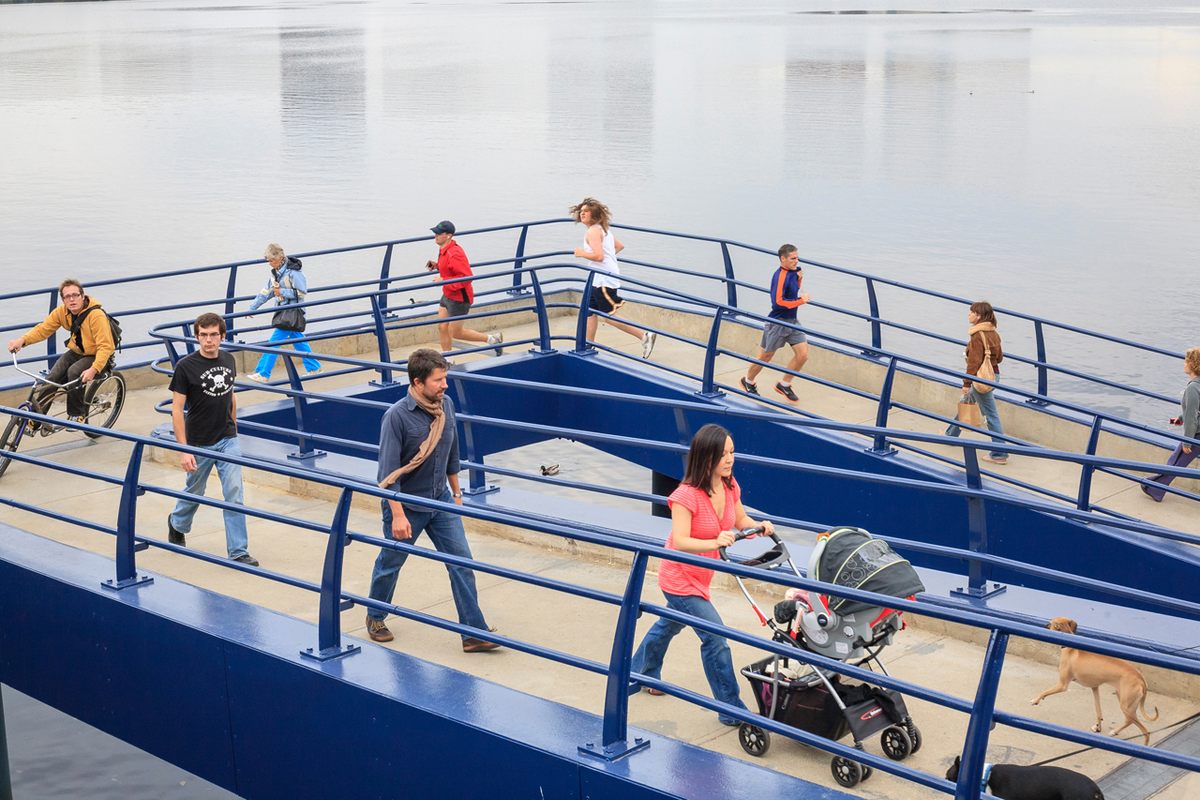
Why do you make images about chaos?
There’s a chaotic, twisting, writhing feeling in my work, but it’s also very ordered. I’ve carefully put the image together for reasons that are not completely conscious: They’re compositional. I don’t go in with a plan, because the physical manifestation is the plan: “This person looks right next to this person.”
It’s a feeling related to the real world, but it really is this thing inside of me: I want a chaos that is also kind of ordered. It’s somewhere between heaven and hell.
Speaking of real and unreal worlds, you’ve been debuting your reworked images on Instagram. How do you feel about the app as a medium for exhibiting photography, especially when gallery shows and other traditional avenues aren’t options?
[Instagram] has kept me as sane as I am. If it wasn’t owned by Facebook, I’d say it was great. It is a little creepy, but the original spirit still seems to be there; I don’t feel like I’m being soaked for advertising. I use it for following art accounts. And even if it’s an artist I like, if they start posting about their trips or food or stuff at home, I unfollow.
I was surprised that people really like my reworked posts (although they like them less than my pure sports pictures). I wanted people to see the crisis immediately, and Instagram is good for that.
The issue of scale is also interesting on Instagram, be it a plus or minus. Ideally you would see my prints very large, and you would be able to walk in a room and identify scenes all over, even on the ceiling. That doesn’t work on a small screen. In traditional photography, it’s like a sin to crop. But for me, it’s fun to fill the Instagram frame … It’s a profound thing that you only have this much space to play with, where only close-ups or middle-distance shots really work.
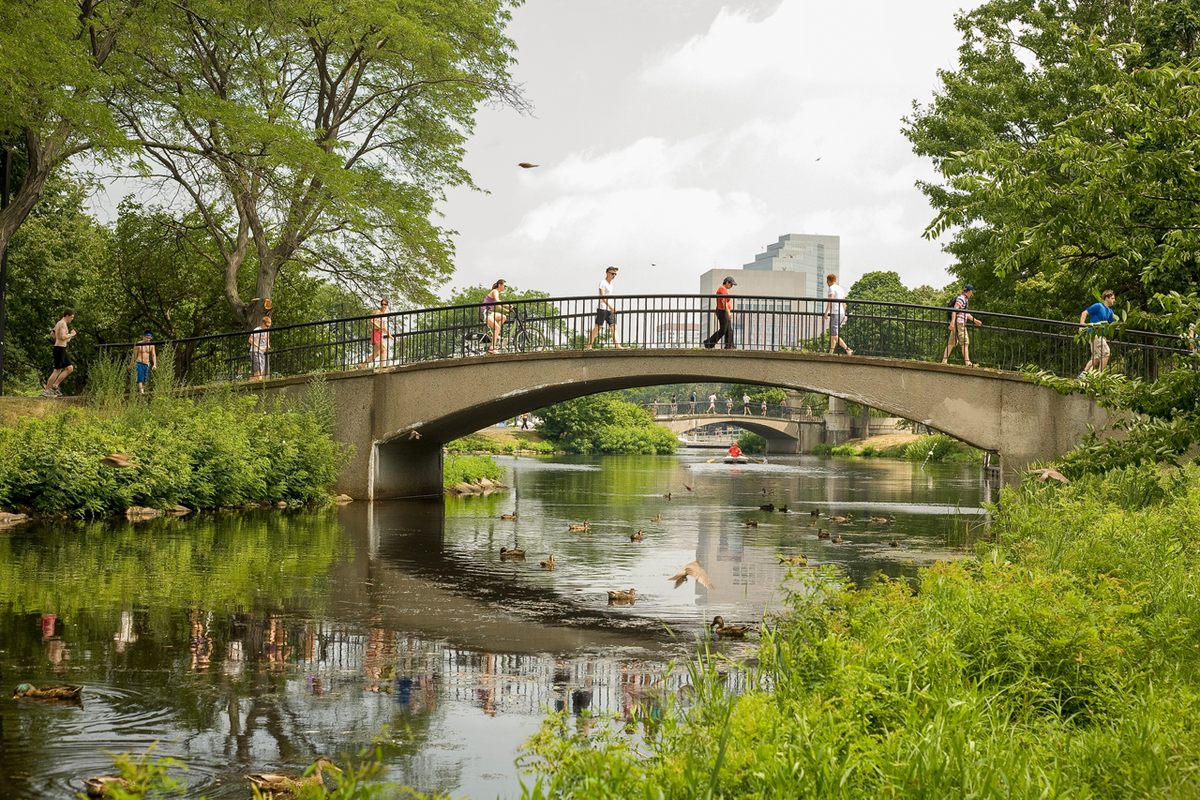
Your “selected people” are very rarely special people—the kinds of characters that make you stop in the street. Why photograph the mundane?
Early in my visual art education, I had a teacher who said, “Go out and take pictures. Then turn around and take a picture of whatever is behind you.” It’s not a novel idea anymore to turn your back on a beautiful sunset to take a picture of people looking at a beautiful sunset—that is now understood as photography that shows how photography mediates our world.
Looking for the marginal things instead of the main thing has always been second nature for me. I don’t even see the obvious. It’s almost a personality trait that I am attracted to the person talking on the phone or looking down instead of up. A lot of it is intentionally random in the way that regular street photography is …
But I will often pick figures for reasons other than what they’re doing or what they look like. They’re included because of where they’re standing. So that brings in all kinds of details that you wouldn’t think to photograph, or that are marginal. I’m making fun of street photography a little bit, and drawing on its rules at the same time.
This interview has been edited and condensed for length and clarity.


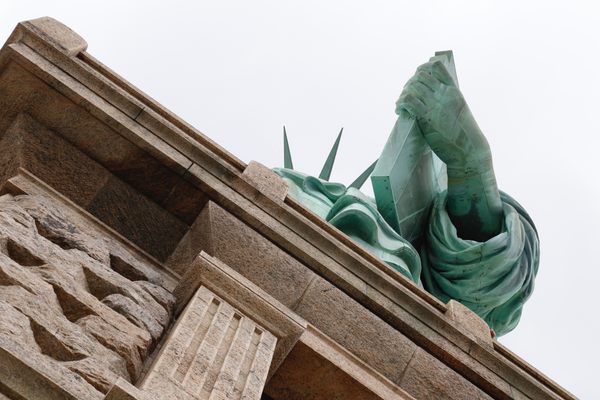










Follow us on Twitter to get the latest on the world's hidden wonders.
Like us on Facebook to get the latest on the world's hidden wonders.
Follow us on Twitter Like us on Facebook